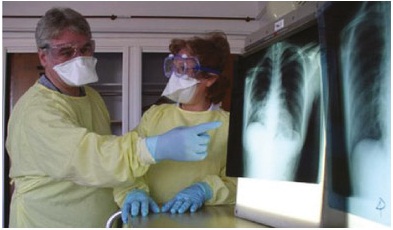1.9 Emerging infectious diseases
Emerging infectious diseases (EIDs) is the collective term for a group of conditions that pose new threats to human health. EIDs can be distinguished into three types:
New infectious diseases caused by previously unknown pathogens:
Many of the diseases in this category are caused by zoonotic viruses, i.e. the viruses originated in other vertebrate animals, but at some point in the past they changed in ways that made them infectious to people. The best known ‘new’ infectious disease is AIDS but the virus that causes AIDS (HIV) may have originated in monkeys. Since HIV was identified in 1984, several other new infectious diseases caused by potentially fatal viruses have been identified. They include SARS (Severe Acute Respiratory Syndrome, Figure 12), which may have originated in poultry, MERS (Middle East Respiratory Syndrome), which may have originated in camels, and zoonotic strains of influenza (swine flu and bird flu).
 Figure 12 Doctors in Toronto struggled to contain SARS in 2002; the highly infectious virus was spread to Canada by a passenger on a flight from Hong Kong.
Figure 12 Doctors in Toronto struggled to contain SARS in 2002; the highly infectious virus was spread to Canada by a passenger on a flight from Hong Kong.Infectious diseases that have spread far outside their original range:
One example is Ebola virus disease (EVD), a ‘haemorrhagic’ [hemm-orr-adj-ik] fever, which means it causes severe internal bleeding, among other symptoms. Cases have occurred from time to time in remote villages in West Africa, but the first urban cases were detected in the capital of Guinea in February 2014 and from there Ebola quickly spread to neighbouring Liberia and Sierra Leone. A few travellers or health workers caring for Ebola patients developed the disease in other countries, including Nigeria, Mali, Senegal and the USA. By October 2015, over 11 000 deaths had occurred from over 28 000 suspected, probable and confirmed cases (Centers for Disease Control and Prevention, 2015). Many of these cases have not been confirmed in a laboratory, so the ‘case fatality rate’ (the proportion of confirmed infected people who die) is unknown; however, it is likely to fall within the range of 30 to 60 per cent.
Previously declining infectious diseases that have resurged:
Tuberculosis and some other infections caused by bacteria are a growing health concern because the causative pathogens are becoming increasingly resistant to antibiotics, which previously treated them successfully. So-called ‘hospital super-bugs’ are bacteria that have developed resistance to antibiotics in health care facilities, where antibiotics are heavily prescribed. An additional factor in countries where HIV/AIDS is common is that infection with HIV suppresses the body’s immune defences, so people with AIDS are more susceptible to other infections, including TB.
